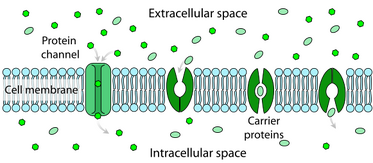Passive transport
Passive transport is the transfer of substances across the cell membrane that occurs spontaneously through channels and carrier proteins . Unlike active transport , this process does not consume any chemical energy ( ATP ). Passive transport depends on the permeability of the cell membrane, which depends on the arrangement of the double layer of phospholipids and interspersed proteins. The basic types of passive transport are simple diffusion , facilitated diffusion and osmosis . In facilitated diffusion, unlike simple diffusion, substances must use carriers or channels.
Electrochemical potential gradient[edit | edit source]
The process of passive transport is controlled by the concentration gradient and the membrane potential . These forces add up to a total force called the electrochemical potential gradient . It is the difference of electrochemical potentials on the outside and inside of the membrane that is the driving force for the movement of ions across the membrane.
Transporter proteins[edit | edit source]
For the transfer of a solute (transmitted chemical substance) from the outside of the cell to the inside, we recognize 2 mechanisms of permeation through proteins.
- The carrier protein uses its conformational changes to transport the solute, which enable it to transport small water-soluble molecules.
- A channel protein is a hydrophilic pore that does not need to change its conformation to transport specific inorganic ions. Therefore, this method of transfer is faster than the previous type. The conformation of a protein can be open or closed.
When transported by carrier proteins, transported molecules can pass independently. We call this process uniport . Or the molecules can pass in parallel, which is cotransport . We divide it into symport and antiport . In symport transfer, molecules pass in the same direction, and in antiport transfer, they pass in the opposite direction. These processes also work during active transport.
Ion channels[edit | edit source]
A cell also uses ion channels to transport ions across its membrane . These are mainly controlled by the binding of acetylcholine to the binding site. Very few channels open without the action of acetylcholine. The channels are further controlled by voltage, mechanically or chemically. The ion channel is highly selective, which is caused by the negatively charged chains of amino acids. Therefore, the channel only lets positively charged ions, for example K + , Na + . Ion channels also work on two basic principles - ion selectivity and channel closability. Ion selectivity means that the channels transport one ion or allow the cotransport of several ions. Closability indicates that channels are sometimes open or closed. However, it always depends on the constant ratio of open and closed channels in the cell membrane. More information on the ion channels page .
Links[edit | edit source]
Related articles[edit | edit source]
Source[edit | edit source]
- ŠVÍGLEROVÁ, Jitka. Passive transport [online]. The last revision 18. 2. 2009, [cit. 12.11.2010]. <https://web.archive.org/web/20160306065550/http://wiki.lfp-studium.cz/index.php/Pasivní_transport>.
- KODÍČEK, M. – KARPENKO, V.. Biophysical chemistry. 1. edition. Prague : Academia, 2000. ISBN 80-200-0791-1.
- VAJNER, Luděk – UHLÍK, Jiří – KONRÁDOVÁ, Václava. Medical histology 1. 1. edition. Prague : Nakladatelství Karolinum, 2012. ISBN 978-80-246-1860-9.

